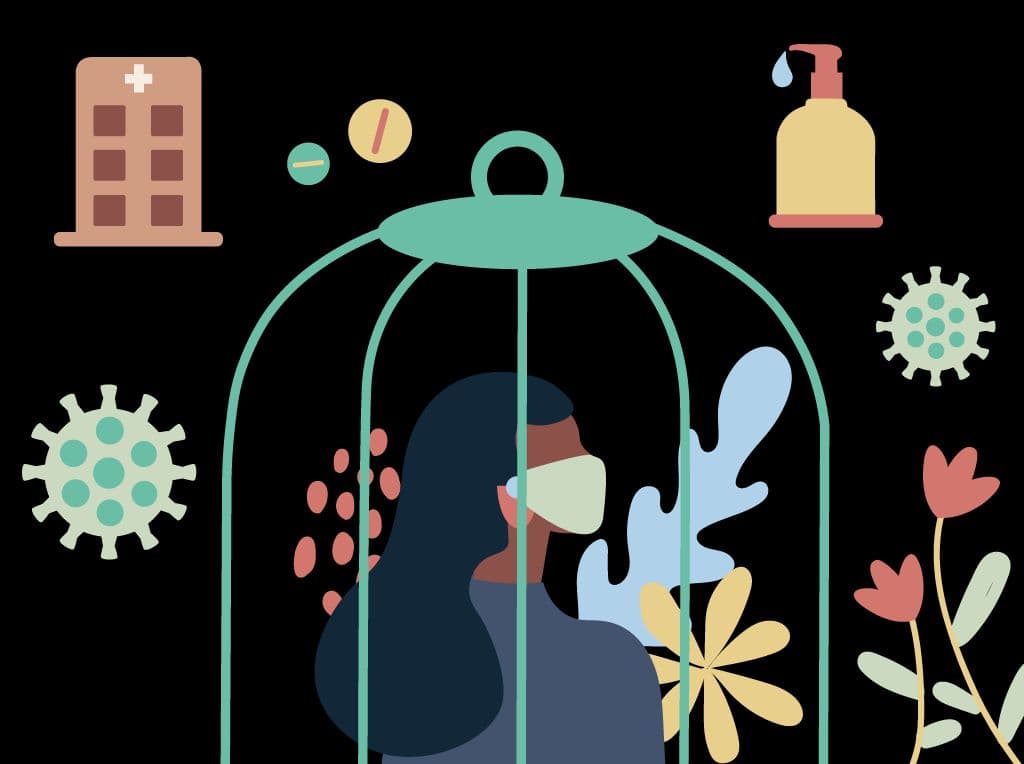This blog is compiled by Athira Krishnan, a content writer for Proactive For Her.
What are the after-effects of Covid-19?
Although most people with COVID-19 get better within a week of illness, some people experience post-COVID conditions.
Post-COVID conditions are a wide range of new, returning or ongoing health problems people can experience from 4 weeks to longer.
Some of the symptoms you may experience post-illness are –
- Tiredness or fatigue
- Headaches
- Loss of taste or smell
- Dizziness upon standing
- Shortness of breath or difficulty breathing
- Joint or muscle pain
- Fever
- Depression or anxiety
How does physiotherapy help?
The body tends to be weakened and you might experience some amounts of fatigue. You may also suffer from shortness of breath. Physiotherapy focuses on strengthening your muscles, increasing your mobility and increasing your lung capacity. The simple exercises involved will greatly increase the rate of recovery.
What are some physiotherapy exercises that can be done?
Breathing exercises
Repetitions for each exercise mentioned below are 5-7 times with 10 times being the maximum. They can be done every 3-4 hours. Take care to not hold your breath while doing any of these exercises.
- Diaphragmatic breathing exercise- The diaphragm is a large muscle that is present at the base of the lungs. When you inhale, the diaphragm contracts and when you exhale, it relaxes. Diaphragmatic breathing is also called ‘belly breathing’ as it fully engages the abdominal muscles and the diaphragm while breathing.
This exercise involves actively pulling the diaphragm down, with each breath. By doing this, it helps to fill the lung with more air, thus increasing lung capacity. During this exercise, try and consciously engage your diaphragm while breathing in and out deeply. You will notice your stomach rising and falling and feel a stretching sensation across your stomach. It can be done while sitting, lying down or in the hook lying position (lie down on your back with your knees bent and feet placed on the ground
How to do -
- Place one hand on your chest and the other on your stomach, just beneath the rib cage
- While inhaling, slowly breathe in through your nose and you should be able to feel your stomach expanding.
- While exhaling, slowly breathe out through your nose and you will feel your stomach contract or move inward.
- Repeat this 5-7 times.
The benefits -
- Strengthens the diaphragm
- Improves the stability of all the core muscles
- Increases lung capacity
- Lowers heart rate and blood pressure
- Promotes relaxation
- Pursed lip breathing exercise- This exercise is one of the simplest ways to control shortness of breath. It provides a quick and easy way to slow the pace of your breathing, thus making each breath more effective. This exercise can be done in any position. This exercise is also useful and effective when it is done while climbing the stairs, walking or picking up heavy objects.
How to do -
- Breathe in slowly through your nose while keeping your mouth closed
- Then, breath out through your mouth while pursing your lips (as though you’re whistling or going to blow out a candle)
Benefits -
- Relieves shortness of breath
- Keeps the airways open for longer which then decreases the work that goes into breathing
- Improves ventilation by expelling old air (carbon dioxide) from the lungs to make room for fresh air (oxygen)
- Lateral thoracic expansion exercise- This exercise focuses on the lateral expansion of the rib cage while engaging your core by pulling in your navel to your spine. It can be done in the sitting or hook lying position
How to do -
- Place your palms on your waist so that you feel your lower ribs under them.
- Slowly breathe in while contracting your abdomen.
- You will feel your rib cage expanding into the palms of your hand.
Benefits -
- Increase in lung capacity
- Promotes mobility of the rib cage which then helps you breathe better and helps you move your spine better
Allows your shoulder blades to function correction
- Spirometer - The spirometer is an apparatus that helps in strengthening the lungs and is available in most medical shops. It is used to measure the volume of air that is taken into and expelled by the lungs. It also measures ventilation which is the movement of air in and out of the lungs. In addition, it helps to identify two different kinds of abnormal ventilation patterns. Using this device daily will slowly but surely help with difficulties in breathing
Mobility exercises - These exercises help in strengthening your muscles while increasing your mobility.
- Shoulder abduction
- Standing position - This exercise can be done while standing or lying down
- Standing position - Stand shoulder-width apart and slowly raise your arms to the side with your thumbs pointing upward. Then raise your arms over your head as far as you can without pain. Hold this position for as long as directed
Lying down position - Lie on your back in the hook lying position with your arms extended out to a “T”. Bend your elbow so that your forearm is in the air. - Slowly raise your arms towards the ceiling and fully straighten your elbows. Hold in this position and then slowly return to the starting position.
- Shoulder flexion
- Stand with your feet hip-width apart and hold a small weight on each side.
- While keeping your core engaged and your arms straight, raise your arms in front of you until they are at your shoulder height.
- Do make sure that your palms are facing each other
- Pause, then slowly lower the weights back to the starting position and repeat
- Ankle-toe movement
- While in a seated position, stretch your legs forward and rotate them clockwise and counterclockwise.
- Another exercise that can be done is by placing your heel on the floor and move your toes up and down. Similarly, place your toes on the floor and lift your heel up and down.
- Knee flexion exercise
- While standing, slowly left your left knee to a 90-degree angle while keeping your right foot straight. Hold for a few seconds and then release. Repeat the same with your right leg lifted.
- Knee extension exercise
- Sit on a table or desk with your legs hanging freely and place a small cushioning/pad under your left knee so that the knee is slightly higher than the hip.
- Now slowly extend your leg with your toes pointing upwards till your leg is straight, without bending the knee.
- Hold for 3-5 seconds, release, then repeat the same with the other leg
Cupping therapy, chest vibrations and proning are a part of physiotherapy in intensive care and for patients who are admitted to hospitals.
In conclusion - Even with all the uncertainty that revolves around the COVID-19 virus, the role of physiotherapy during recovery has been found to be extremely beneficial overall. Regular practise of these exercises will surely make a noticeable change in your road to recovery.
Disclaimer - This information is provided for educational purposes and should not be construed as medical advice. Please consult with your healthcare practitioners before undertaking any changes in your diet or adding supplements.
Proactive is a digital clinic for women, offering accessible, personalized, and confidential healthcare solutions. We offer products and services for out-patient health concerns of Indian women, across their lifetime - from puberty to pregnancy to menopause. To know more on the sexual and reproductive health of women, visit https://www.proactiveforher.com/

